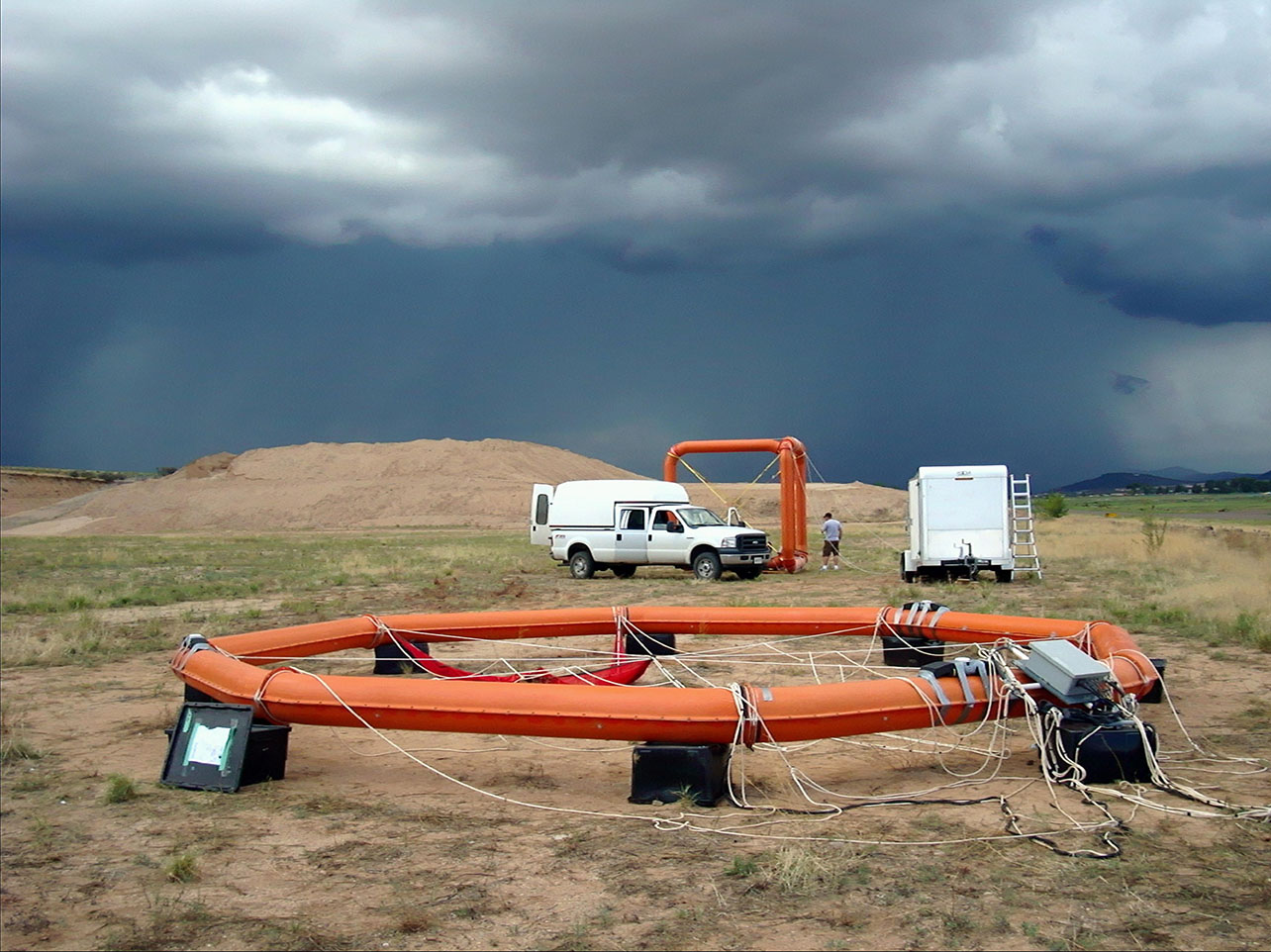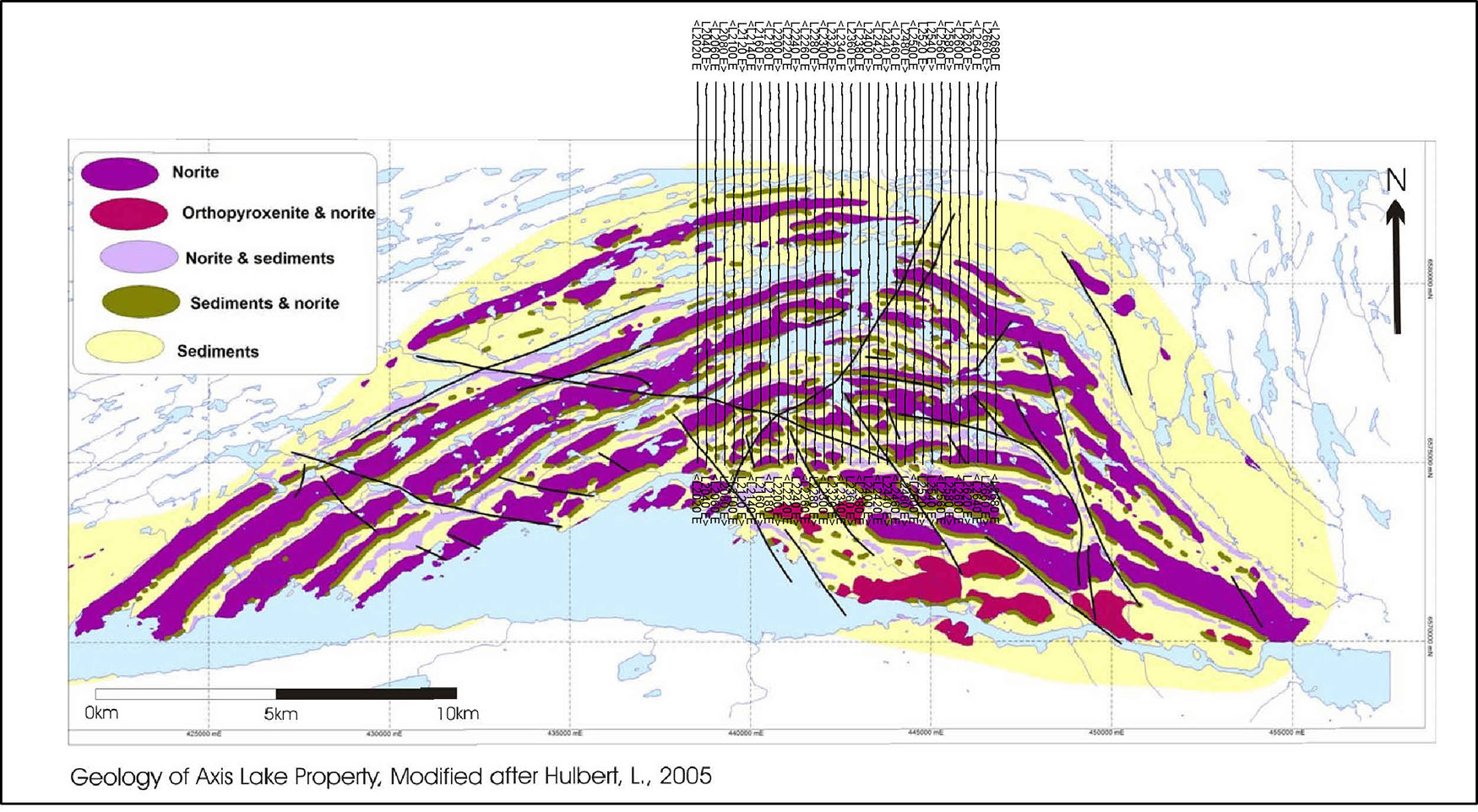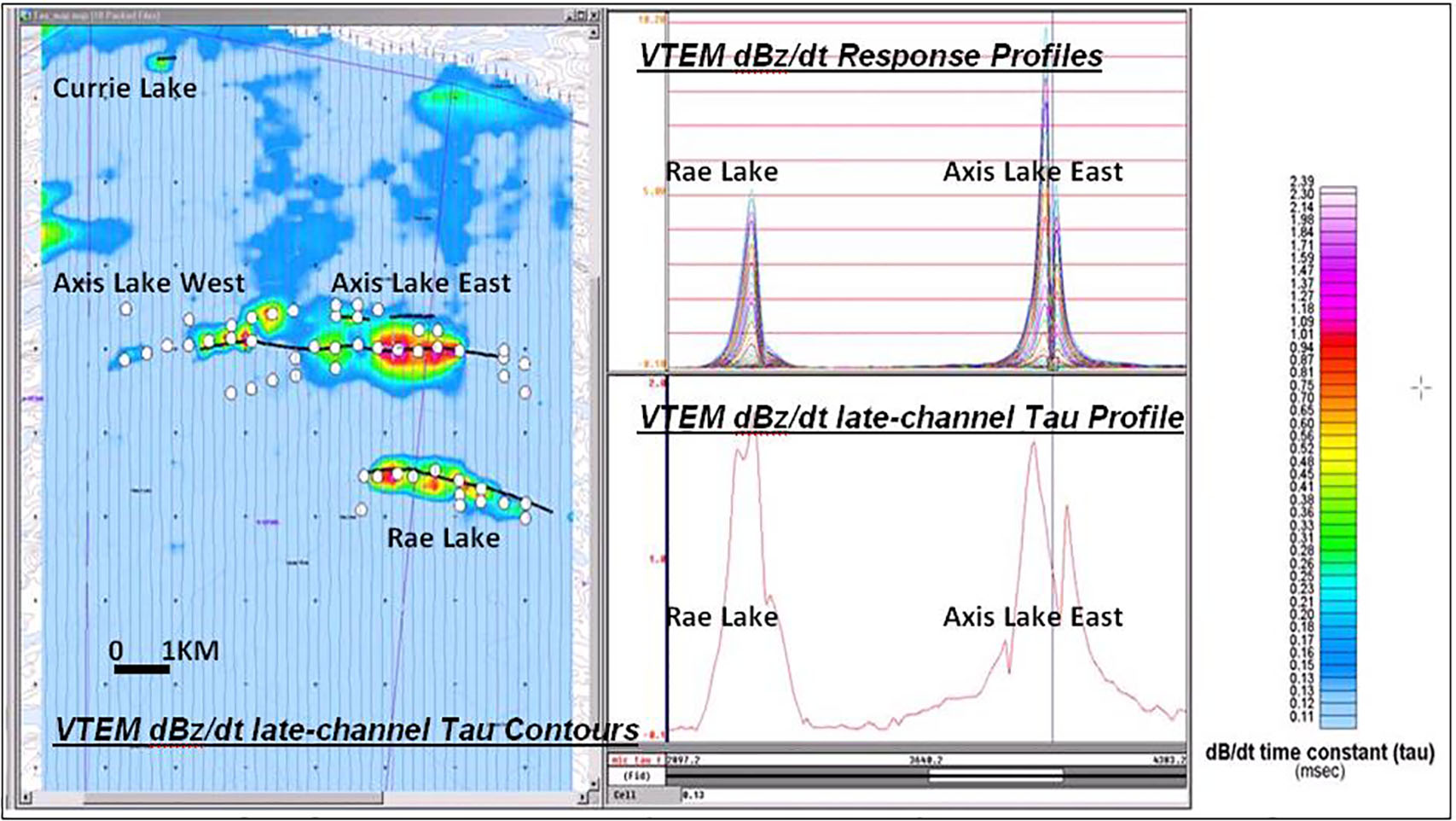Presented at SEG 2009
For a PDF of this paper abstract click here.
For a PDF of this paper’s expanded abstract click here.
Summary
An airborne AFMAG demonstration test survey was con-ducted using the ZTEM tipper electromagnetic prospecting system over a known magmatic copper-nickel occurrence in northern Saskatchewan, Canada. These tests were con-ducted in early 2008 and were flown to test the system’s capability to detect the conductive but relatively weakly mineralized sulphide deposits and to define potential exten-sions at depth. The AFMAG method utilizes naturally oc-curring audio telluric fields from worldwide sferic activity as its primary field source and is capable of large penetration depths – in the order of hundreds of metres to km. The AFMAG field tests corroborate previously airborne transient electromagnetic, magnetic and ground follow-up EM surveys. 2D forward modelling results agree with the >300m vertical depth extent as defined in subsequent diamond drill testing.
Introduction
Airborne tipper AFMAG (audio frequency electromagnet-ics) surveys were conducted over the Axis Lake property that is situated in the Fond du Lac region of northern Sas-katchewan (Figure 1) in May, 2008 (Milicevic et al., 2009). The survey consisted of Tipper AFMAG measurements using the ZTEM system (Lo and Zang, 2008), shown in Figure 2, as well as aeromagnetics using a caesium magne-tometer. The survey was comprised of thirty four (34) ap-proximately 10.5 km long, North-South oriented flight lines, totalling 358.7 line-km, that were obtained at nominal 250m line spacing over an approximately 8 x 10km area (Figure 3). The property hosts known copper-nickel sulphide showings (Axis Lake East & West, Rae Lake and Currie Lake), has been previously surveyed using the VTEM (Witherly et al., 2004) helicopter EM system, with ground follow-up using UTEM (West et al., 1984) surveys, and has subsequently been drilled (Vivian and Lo, 2007). The property was chosen to test the ZTEM capability to identify and define potential along strike and deep extensions of the known Cu-Ni mineralization to below 500m.
The measurements of the vertical (Z) tipper data were obtained using an air coil system (Figure 2), suspended at approximately 100m elevation above ground level. The vertical component data (Hz) were then ratioed to fixed horizontal field measurements (Hx-Hy) obtained using identical reference coils, that were oriented in the in-line (X) and cross-line (Y) directions, in order to obtain the tipper functions Z/X and Z/Y. The In-Phase and Quadrature components tipper ratio data were then extracted from the time-series, using Fourier-based, digital signal processing analyses, at 5 frequencies, between 30Hz and 360Hz.
General Theory
The ZTEM system uses naturally occurring AFMAG mag-netotelluric fields as the source of the primary fields, and therefore requires no transmitter (Ward, 1959). The fields resemble those from VLF except that they are lower fre-quency (tens & hundreds of Hz versus tens of kHz) and are not strongly directionally polarized (Labson et al., 1985). These AFMAG EM fields, derived from world wide at-mospheric thunderstorm activity, have the unique charac-teristic of being uniform, planar and horizontal, and also propagate vertically into the earth – to great depth, up to several km, as determined by the magnetotelluric (MT) skin depth (Vozoff, 1972), which is directly proportional to the ratio of the bedrock resistivity to the frequency. At the frequencies used for ZTEM, the MT skin depths likely range between approx. 600m to 2km in this region, according to the following equation for the Bostick skin depth (Mu-rakami, 1985):
δs = 356 * √(ρA / ƒ) metres
The other unique aspect of AFMAG fields is that they react to relative contrasts in the resistivity, and therefore do not depend on the absolute conductance, as measured using inductive EM systems, such as VTEM – hence poorly con-ductive targets, such as alteration zones and fault zones, can be mapped, as well as higher conductance features, like graphitic units. Conversely, resistive targets can also be mapped using AFMAG– provided they are of a sufficient size and contrast to produce a vertical field anomaly. Indeed resistors produce reversed anomalies relative to conductive features. Still, copper-nickel mineralization is consistent with moderate to strongly conductive bodies.
Geological Setting
The Axis Lake property is located in the Tantato domain, Fond du Lac area, north-northeast of Lake Athabasca. The Tantato domain is defined as a triangular area underlain by granulite to upper amphibolite facies metamorphosed sedi-ments, volcanics, and granitoids (Figure 3). Mineralization on the Axis Lake property is associated with magmatic nickel-copper sulphides. Mineralization has been transported along a prominent fault conduit formed in an extensional rift environment. Norite magmas containing sulphide droplets settle out of the magma in areas where differentiation of the magma occurs. (Vivian and Lo, 2007).
The rocks at Axis Lake consist mainly of diatexite, which is a highly metamorphosed sediment, and mafic noritic granulites, which are metamorphic plutonic rocks. Geologic mapping has been assisted with the aid of the property-wide Total Field Magnetic survey and further delineated the diatexite and mafic granulite units as shown in Figure 3. Diatexite sediments occupy areas of low magnetic response while the metanorite is coincident with the high magnetic signatures.
**figure 4 and 5
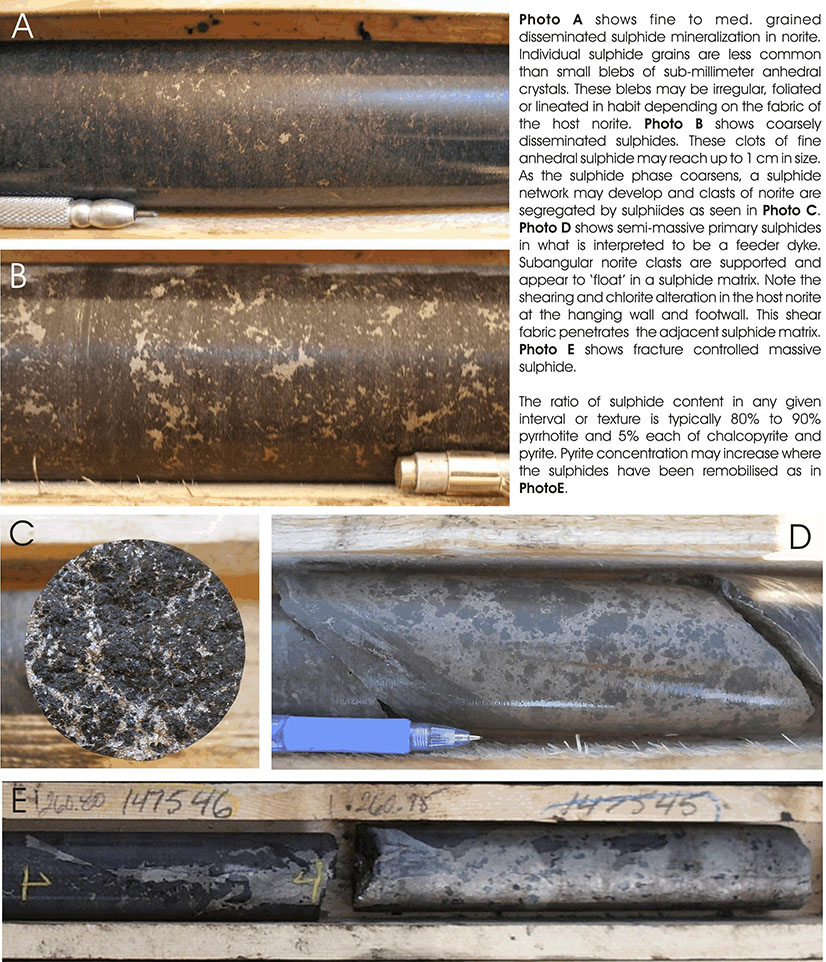
Figure 4: Slide showing texture of sulphides in Axis Lake diamond drill core (after Vivian and Lo, 2007).
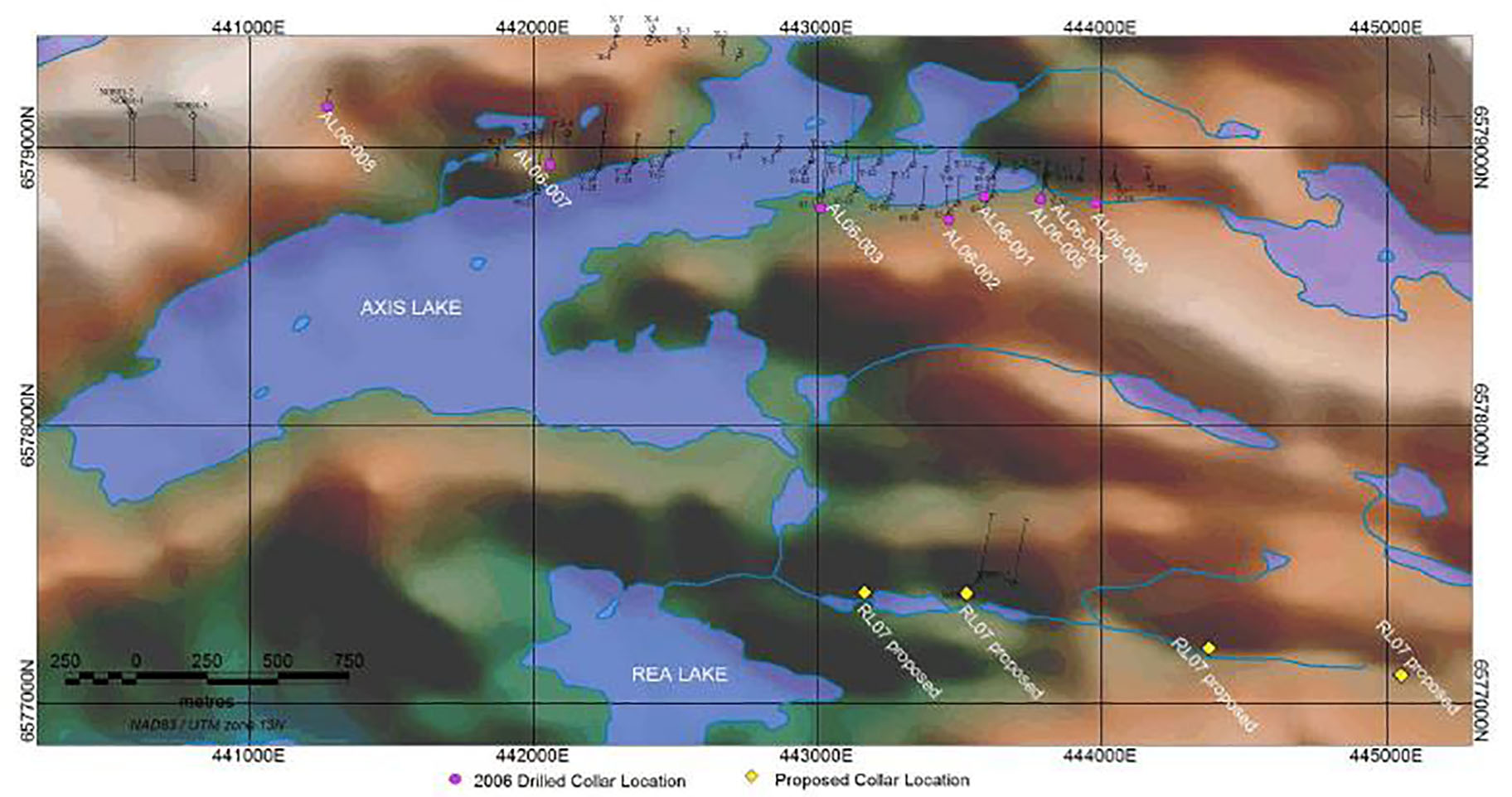
Figure 5: Existing Diamond Drill-holes, 2006 Holes and Proposed drill-holes over DEM model (Vivian and Lo, 2007)
Pyrrhotite dominates the sulphide mineralogy at the Axis, Rae and Currie Lake Zones (Figure 4). There are three styles of mineralization: 1) fine to coarsely disseminated, from 1-5% and up to 10% sulphides; 2) network to net-textured mineralization of up to 15% sulphide, trending to 30%; and 3) massive sulphide horizons comprising up to 50% miner-alization but occurring only locally in zones less than 0.5 m thick. Sulphide mineralogy is dominated by pyrrhotite (up to 90%) with accessory compositions of chalcopyrite (up to 5%) and pyrite (usually less than 5%). The nickel-bearing sulphide is pentlandite and it is also common to see the nickel to copper ratios approximately 2:1 to 3:1 (Vivian and Lo, 2007).
Seven diamond drill holes, totaling 2260 metres were completed in Spring 2006 that were located based on the 2005 VTEM and 2006 UTEM results and to infill Cu-Ni mineralization intersected previously (Figure 5). All holes intersected Cu-Ni sulphides. The results showed that the sulphide mineralization in the East and West zones ranges from fine to coarsely disseminated, to semi-massive network textures to massive, with nickel and copper values in the range of 1-2% and 0.4-0.6% respectively. Rae Lake remains untested (Vivian and Lo, 2007).
Previous Geophysical Survey Results
VTEM and aeromagnetic surveys were undertaken in March, 2005 at 150-250m line-spacings and totaling 1503 line-km (Orta et al., 2005). Over 40 conductive responses were identified in the VTEM data and the results show that the Axis Lake zone EM response is quite varied and less extensive than the known mineralization (Figure 6). The East Zone dips south and reveals better amplitudes due to better connectivity than the West Zone. The Rae Lake zone also dips south, is more continuous but is slightly less conductive than Axis Lake. The Currie Lake zone dips north but is indicated to be of limited size. Additional areas for ground follow-up were also defined elsewhere on the property (Vivian and Lo, 2007).
The VTEM survey outlined numerous conductive responses on the Axis Lake property, including 4 significant areas at Axis Lake East & West, Rae Lake and Currie Lake. In particular, modeling suggests that mineralization at Axis and Rae Lakes extends to 400+ metres. South dips are indicated at Axis and Rae Lakes, and steep dips at Currie Lake. The 5-10 siemens conductivities obtained suggest that the Cu-Ni sulphide mineralization is weak, likely semi-massive, particularly at Currie Lake (Vivian and Lo, 2007).
AFMAG Survey Results
There are distinctive differences observed between the Z/X (In-Line) component profile results (Figure 7A), which are most sensitive to structures orientated perpendicular to the In-Line direction – notably the 2 prominent, thin EW lineaments that are centered directly over the known Axis Lake East & West and Rae Lake mineralized zones; as well as 2 major EW conductive zones located south and north of Currie Lake – the latter of which appears correspond to the Tantato Domain contact, and might represent a major regional fault structure. Another unexplained EW conductive lineament represents a New Target, that is along strike with a VTEM anomaly defined southwest of Currie Lake. This image contrasts the Z/Y (Cross-line) component profiles (Figure 7B), which are sensitive to structures oriented oblique/parallel to the In-Line flight direction. Indeed the Z/Y images are less well defined except for a SW-NE lineament extending across Axis Lake zone, potentially relating to a fault structure; and the Tantato Domain boundary to the north which is equally as prominent as in the Z/X results, presumably because it is NE-SW oriented.
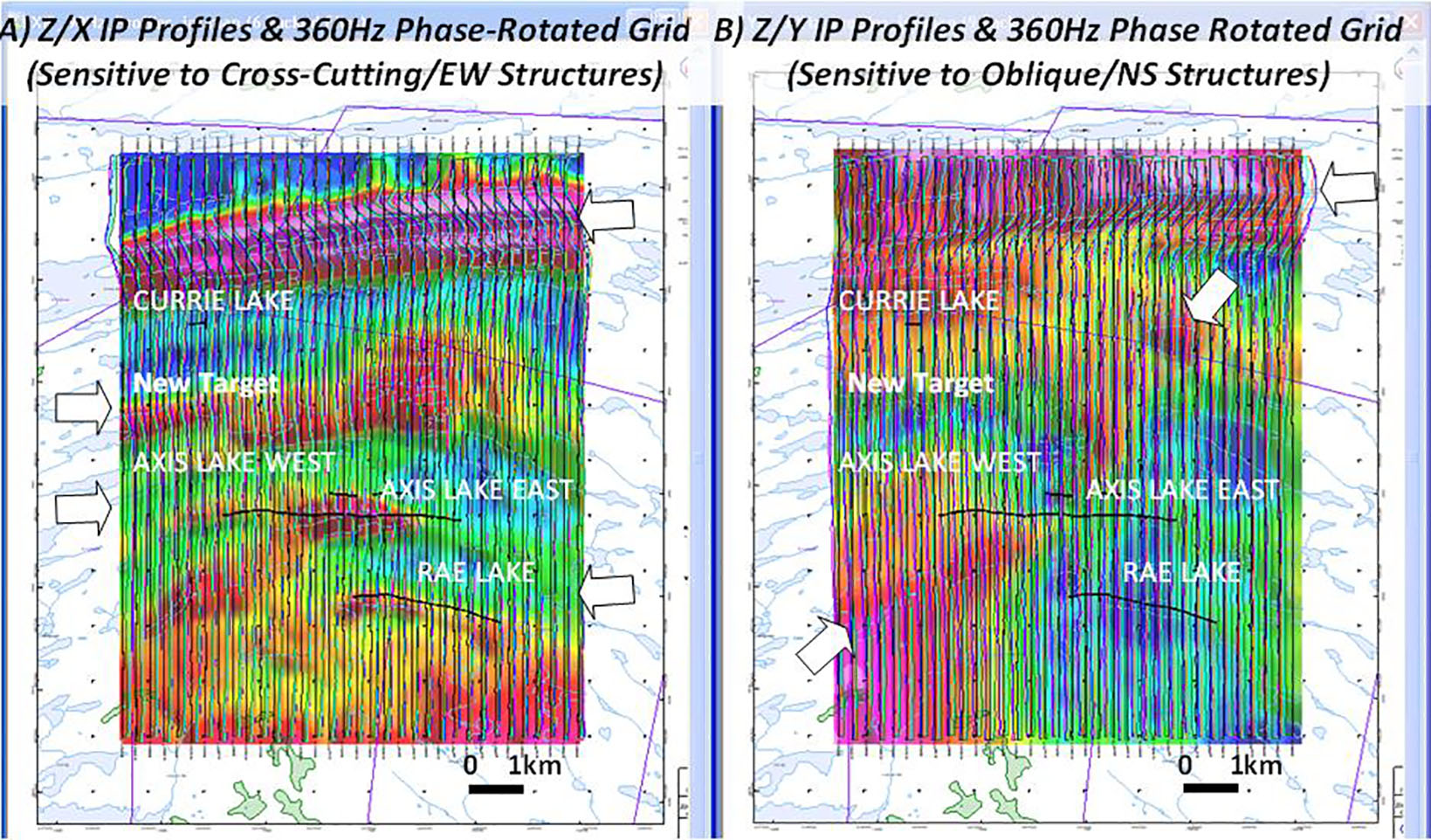
Figure 7: Axis Lake ZTEM Test Block: In-Phase Z/X Compo-nent Profiles over 360Hz Phase-Rotated (PR) Grid (left) versus Corresponding In-Phase Z/Y Profiles & 360Hz PR Grid (right).
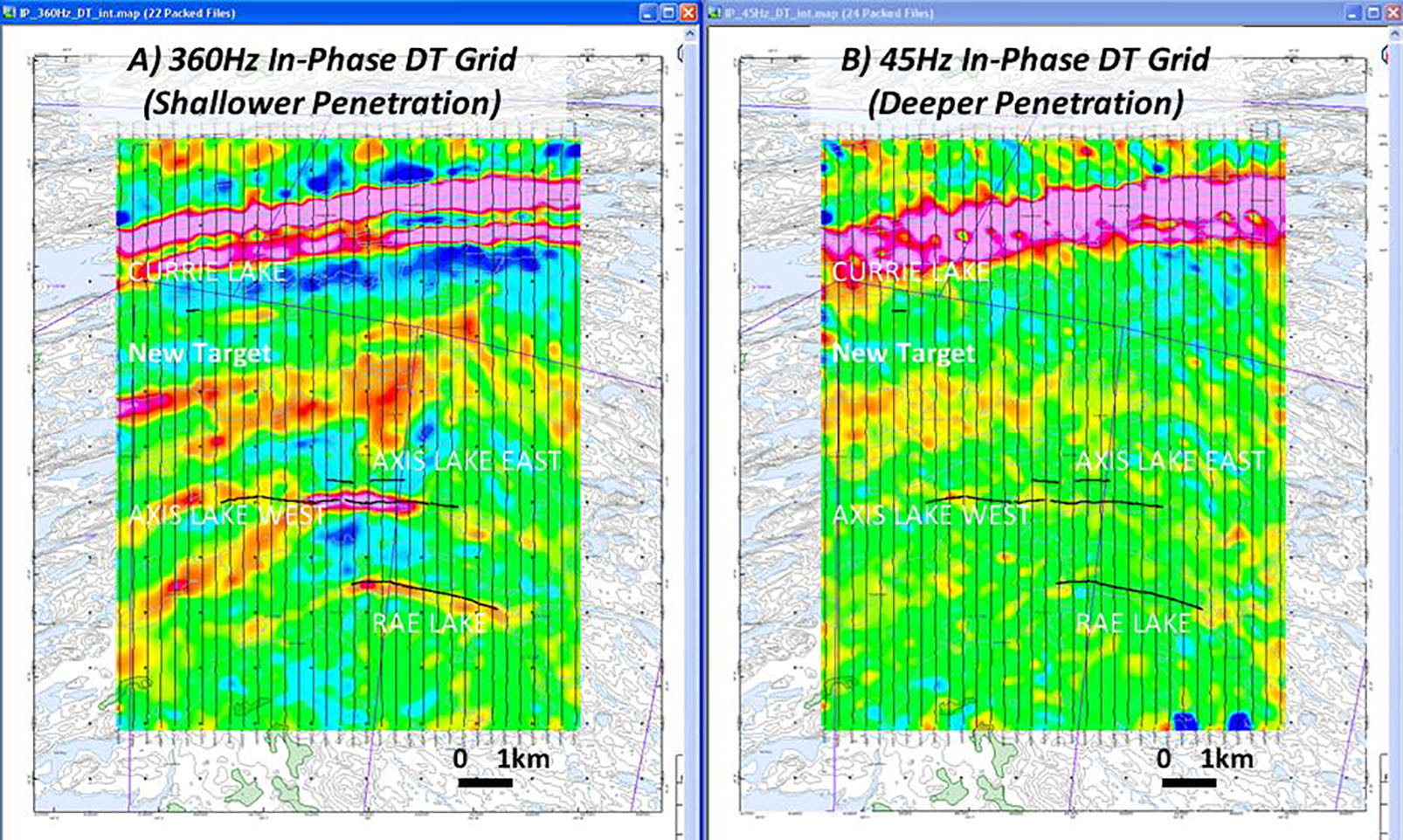
Figure 8: Axis Lake Block: 360Hz In-Phase Total Divergence (DT) Grid (left) versus Corresponding 45Hz In-Phase DT Grid (right) and Mineralized Zones.
When the 2 Tippers are combined, using the DT (Kuzmin eta l., 2005) grid method (Figure 8) that is analogous to the VLF Peaker (Pedersen, 1998), the imaging of geoelectric struc-tures becomes omni-directional, with all structures being highlighted. The DT (total divergence) images at 360Hz and 90Hz shown below each also demonstrate the notable differences in the frequency-dependence of the responses, that imply resolved differences in the vertical depth of the defined structures – including: a) the main Axis Lake and the Rae Lake Zone responses, that rapidly weaken from high to low frequency, and b) similarly for the New Target and the Currie Lake zone, barely visible. This suggests that they relate more to the near-surface ge-ology and may not extend to significant depths. These behaviours contrast the main Tantato Domain contact zone response, furthest north, which is equally strong from 45 Hz to 360Hz in both the Resulting PR and DT images. This suggests that it represents a major crustal fault feature, with great depth extent.
Two-dimensional MT Tipper Forward Modelling
2D synthetic data were obtained that simulate and compare the expected Tipper responses for the Axis Lake geologic model using the PW2d 2D forward MT modeling code of Wannamaker et al. (1987).
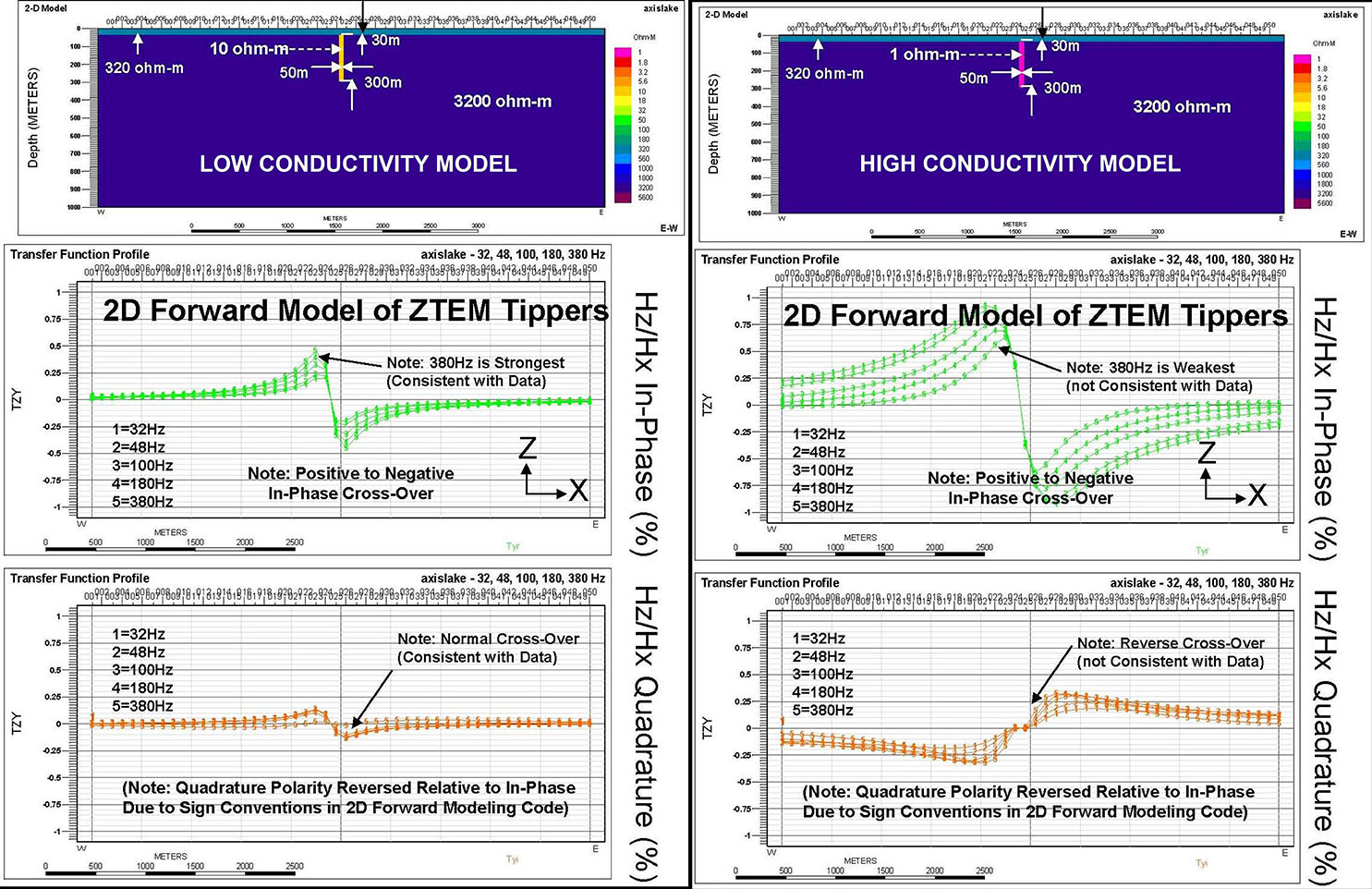
Figure 9: Axis Lake 2D Resistivity Models and 2D Forward Model Z/X profiles for low conductivity model (left) and high conductivity model (right), extending to 300m depths.
Figure 9 presents the 2D synthetic forward model responses of the In-line (Z/X) In-Phase and Quadrature for 2 similar geologic models, whose only dissimilarity is the target conductivity, which is 10x less for the low conductivity model (10 ohm-m=5 siemens), shown on the left, versus the high conductivity model (1 ohm-m = 50 siemens), shown on the right. The notable similarities that the low conductivity model have with the measured data are: a) In-Phase (IP) responses that diminish in amplitude at lower frequencies, and b) Quadrature phase (QP) responses that follow the same polarity as the In-phase (note the reversed sign for QP relative to our measured results is due to polarity convention in MT 2d code utilized), and c) model amplitudes for the IP and QP for the low conductivity model closely match the observed data (i.e., +/- 40% IP and +/- 10% QP – Figure 10) and are significantly weaker than for the high conductivity model. Hence the 2D forward modeling results suggest that the Axis Lake mineralized zones are only moderately conductive (~5 siemens) and may not extend to significant depth (~300-500m) – both of which agree with the VTEM and UTEM survey results and the known geology.
Conclusion
The ZTEM results appear to correlate very well with the known geology, in particular the presence of a Cu-Ni mineralized conductive horizons, at Axis Lake and Rae Lake, which are known to occur at surface and are followed along several kilometers along strike. In particular, the ZTEM results provide indications of the longer strike continuity of the known mineralized horizons, as compared to the VTEM results, that likely relate to more weakly mineralized, lower conductivity extensions of the zones (Figure 10). This also agrees with the ground UTEM anomaly trends that extend beyond the known mineralized zones. In fact, an unexplained ZTEM anomaly northwest of the known Cu-Ni showings and south of Currie Lake correlate well with the east-extension of VTEM conductor and therefore represents a new target for follow-up (Figure 10). Other ZTEM lineaments also correlate well with similar areomagnetic trends and structures, which highlight its ability to provide complementary information. In addition to mapping lithology and structure, the ZTEM results appear to corroborate both the moderate conductance (~5 siemens) and the relatively limited vertical depth-extent (~300-500m) of the defined mineralized zones and therefore agree with the previous geophysical and drill-tested geologic findings. These results over a Cu-Ni target add to the variety of succesful applications of the ZTEM technique, notably for sedimentary-exhalative and porphyry copper type deposits (Lo and Zang, 2008), as well as unconformity uranium targets (Lo et al., 2009).
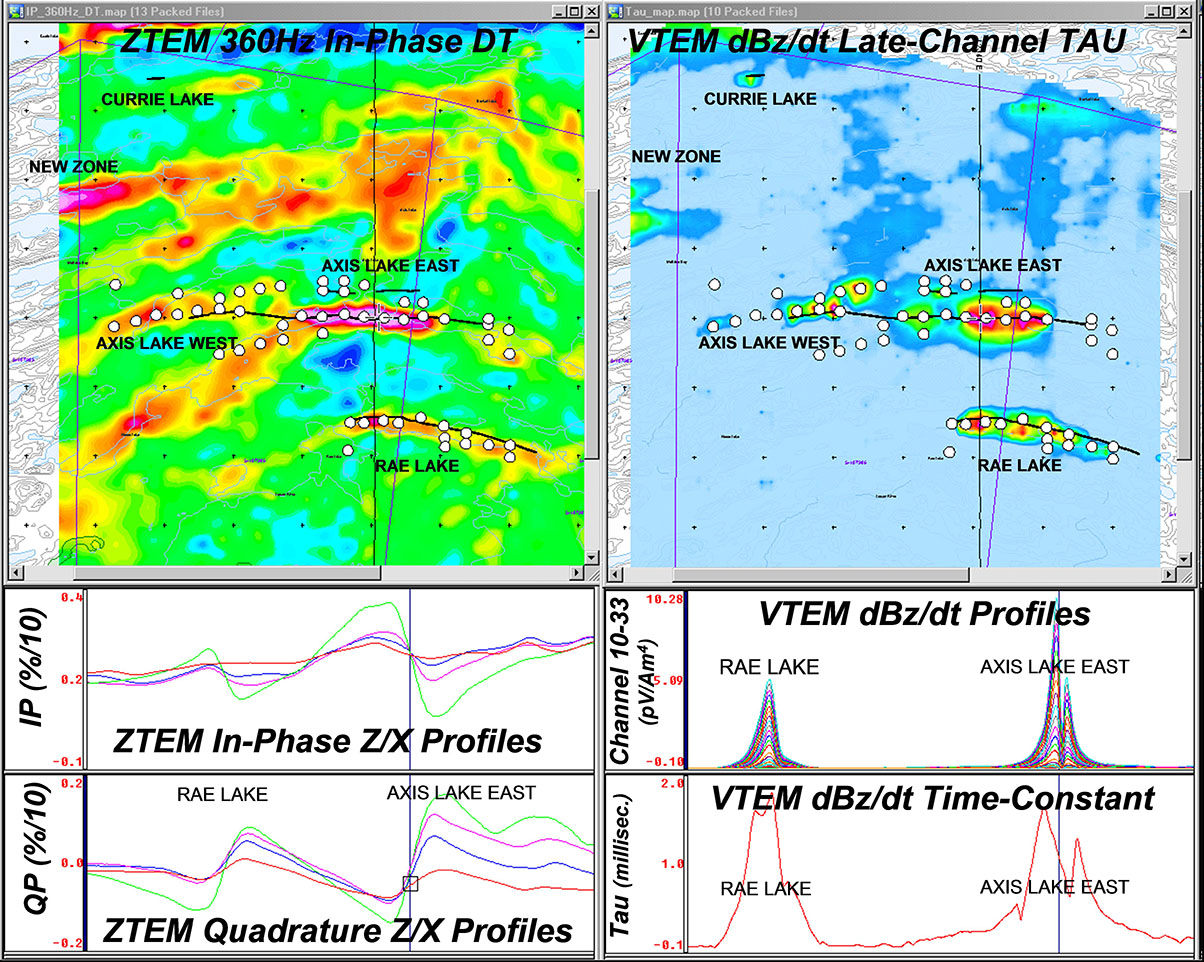
Figure 10: Axis Lake ZTEM 360Hz In-Phase Total Divergence (left), VTEM Late-Channel Tau (right) Results, and related Profile Data, along with Known Mineralized Zones and Ground UTEM Anomalies (circles).
Acknowledgements
The authors would like to thank Geotech Ltd., as well as Pure Nickel Mines Inc. for graciously allowing us to present these data and for providing the geologic and historical geophysical data.
References
Kuzmin, P., Lo, B., and Morrison, E., 2005, Final report on modeling, interpretation methods and field trials of an ex-isting prototype AFMAG system, Miscellaneous Data Release, 167, Ontario Geological Survey.
Labson, V. F., A. Becker, H. F. Morrison, and U. Conti, 1985, Geophysical exploration with audio-frequency natural magnetic fields: Geophysics, 50, 656–664.
Lo, B., and Zang, M., 2008, Numerical modeling of Z-TEM (airborne AFMAG) responses to guide exploration strate-gies, SEG Expanded Abstracts, 27, 1098-1101.
Lo, B., Legault, J.M., Kuzmin, P., 2009, Z-TEM (Airborne AFMAG) tests over unconformity uranium deposits, Ex-tended abstract submitted to 20TH ASEG International Geophysical Conference & Exhibition, Adelaide, AU, 6 pp.
Milicevic, B., Steffler, E., and Legault, J.M., 2009, Geophysical report on ZTEM electromagnetic and magnetic test surveys over Axis Lake property, on behalf of Pure Nickel Inc., internal report by Geotech Ltd., Feb-2009, 36 pp.
Murakami, Y. 1985, Short Note: Two representations of the magnetotelluric sounding survey, Geophysics, 50, 161-164.
Orta, M., Zhu, J., and Barlow, R., 2005, Report on helicopter-borne time-domain electromagnetic geophysical survey, Stony Rapids Project, northern Saskatchewan, for Hull Consulting Services Ltd., internal report by Geotech Ltd., May, 2005, 26 pp.
Pedersen, L.B., 1998, Tensor VLF measurements: Our first experiences, Exploration Geophysics, 29, 52-57.
Vivian, G., and Lo, B., 2007, Technical Report – Organic soil sampling, airborne and ground geophysics and diamond drilling, Fond du Lac property, northern Saskatchewan, on behalf of Pure Nickel Inc., 43-101 report, April, 2007, 63 pp.
Vozoff, K., 1972, The magnetotelluric method in the exploration of sedimentary basins: Geophysics, 37, 98–141.
Wannamaker, P. E., Stodt, J. A., and Rijo, L., 1987, A stable finite element solution for two dimensional magnetotelluric modeling: Geophy. J. Roy. Astr. Soc., 88, 277-296.
Ward, S. H., 1959, AFMAG—Airborne and ground: Geophysics, 24, 761–787.
West, G.F., Macnae, J.C., and Lamontagne, Y., 1984, A time-domain EM system measuring the step response of the ground, Geophysics, 49, 1010-1026.
Witherly, K., Irvine, R., and Morrison, E.B., 2004, The Geotech VTEM time domain helicopter EM system, SEG Ex-panded Abstracts, 23, 1217-1221.

